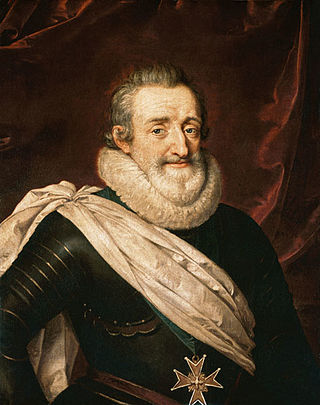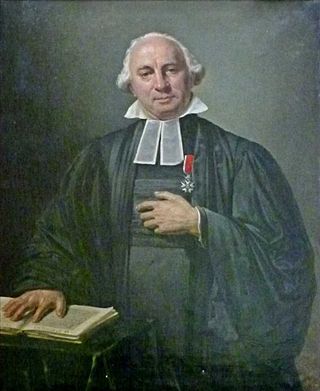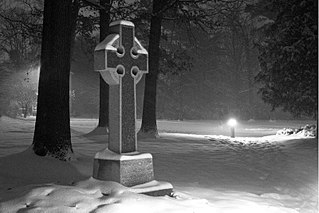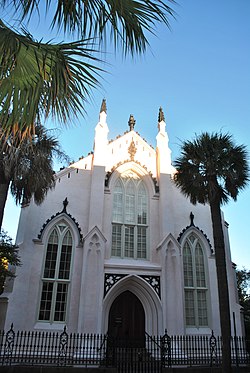
The Edict of Nantes was signed in April 1598 by King Henry IV and granted the minority Calvinist Protestants of France, also known as Huguenots, substantial rights in the nation, which was predominantly Catholic.

The Huguenots were a religious group of French Protestants who held to the Reformed (Calvinist) tradition of Protestantism. The term, which may be derived from the name of a Swiss political leader, the Genevan burgomaster Besançon Hugues (1491–1532), was in common use by the mid-16th century. Huguenot was frequently used in reference to those of the Reformed Church of France from the time of the Protestant Reformation. By contrast, the Protestant populations of eastern France, in Alsace, Moselle, and Montbéliard, were mainly Lutherans.

The French Wars of Religion were a series of civil wars between French Catholics and Protestants from 1562 to 1598. Between two and four million people died from violence, famine or disease directly caused by the conflict, and it severely damaged the power of the French monarchy. One of its most notorious episodes was the St. Bartholomew's Day massacre in 1572. The fighting ended with a compromise in 1598, when Henry of Navarre, who had converted to Catholicism in 1593, was proclaimed King Henry IV of France and issued the Edict of Nantes, which granted substantial rights and freedoms to the Huguenots. However, Catholics continued to disapprove of Protestants and of Henry, and his assassination in 1610 triggered a fresh round of Huguenot rebellions in the 1620s.

The Edict of Fontainebleau was an edict issued by French King Louis XIV and is also known as the Revocation of the Edict of Nantes. The Edict of Nantes (1598) had granted Huguenots the right to practice their religion without state persecution. Protestants had lost their independence in places of refuge under Cardinal Richelieu on account of their supposed insubordination, but they continued to live in comparative security and political contentment. From the outset, religious toleration in France had been a royal, rather than popular, policy.

During the sixteenth and seventeenth centuries, politiques were Western European statesmen who prioritized the strength of the state above all other organs of society, including religion. During the French Wars of Religion, this included moderates of both religious faiths who held that the country could only be saved by the restoration of a strong monarchy which rose above religious differences. The term politique often had a pejorative connotation of moral or religious indifference, especially after 1568 in contrast with the radical Catholic League calling for the eradication of Protestantism in France. By 1588 the politiques were seen by pious detractors as a faction more pernicious than heretics.

A metrical psalter is a kind of Bible translation: a book containing a verse translation of all or part of the Book of Psalms in vernacular poetry, meant to be sung as hymns in a church. Some metrical psalters include melodies or harmonisations. The composition of metrical psalters was a large enterprise of the Protestant Reformation, especially in its Calvinist manifestation.
The Book of Common Order, originally titled The Forme of Prayers, is a liturgical book by John Knox written for use in the Reformed denomination. The text was composed in Geneva in 1556 and was adopted by the Church of Scotland in 1562. In 1567, Séon Carsuel translated the book into Scottish Gaelic under the title Foirm na n-Urrnuidheadh. His translation became the first Gaelic text to be printed in Scotland. In 1996 the Church of Scotland produced "Leabhar Sheirbheisean", a Gaelic supplement to the Book of Common Order.

The French Quarter is a historic district and a section of downtown Charleston, South Carolina, United States, that is listed on the National Register of Historic Places.

The Genevan Psalter, also known as the Huguenot Psalter, is a 1539 metrical psalter in French created under the supervision of John Calvin for liturgical use by the Reformed churches of the city of Geneva in the sixteenth century.

The Reformed Church of France was the main Protestant denomination in France with a Calvinist orientation that could be traced back directly to John Calvin. In 2013, the Church merged with the Evangelical Lutheran Church in France to form the United Protestant Church of France.

The New Church, is located in Berlin on the Gendarmenmarkt across from French Church of Friedrichstadt. Its parish comprised the northern part of the then new quarter of Friedrichstadt, which until then belonged to the parish of the congregations of Jerusalem's Church. The Lutheran and Calvinist congregants used German as their native language, as opposed to the French-speaking Calvinist congregation of the adjacent French Church of Friedrichstadt. The congregants' native language combined with the domed tower earned the church its colloquial name Deutscher Dom. While the church physically resembles a cathedral, it is not a cathedral in the formal sense of the word, as it was never the seat of a bishop.

Hanover House is a colonial house built by a French Huguenot family in 1714–1716, on the upper Cooper River in present-day Berkeley County of the South Carolina Low Country. The house is also known as the St. Julien-Ravenel House after its early owners.

Protestantism in France has existed in its various forms, starting with Calvinism and Lutheranism since the Protestant Reformation. John Calvin was a Frenchman, as were numerous other Protestant Reformers including William Farel, Pierre Viret and Theodore Beza, who was Calvin's successor in Geneva. Peter Waldo was a merchant from Lyon, who founded a pre-Protestant group, the Waldensians. Martin Bucer was born a German in Alsace, which historically belonged to the Holy Roman Empire, but now belongs to France.

The French Protestant Church of London is a Reformed / Presbyterian church that has catered to the French-speaking community of London since 1550. It is the last remaining Huguenot church of London. Its current temple in Soho Square is a Grade II* listed building designed by Aston Webb and erected in 1891–93.
Valérand Poullain (1509?–1557) was a French Calvinist minister. In a troubled career as minister, he was pastor to a congregation of Flemish or Walloon weavers brought to Southwest England around 1548.
Reformed worship is religious devotion to God as conducted by Reformed or Calvinistic Christians, including Presbyterians. Despite considerable local and national variation, public worship in most Reformed and Presbyterian churches is governed by the Regulative principle of worship.

Paul-Henri Marron was the first Reformed pastor in Paris following the French Revolution. Born in the Netherlands to a Huguenot family, Marron first came to Paris as the chaplain of the Dutch embassy. Protestants in France had been prohibited from worshipping openly since the Revocation of the Edict of Nantes in 1685. The Edict of Tolerance in 1787 gave non-Catholics the right to openly practice their religion. Marron was recruited to lead the newly tolerated Protestant community of Paris, a task he accomplished through the French Revolution, several imprisonments, the Napoleonic Wars, the Bourbon Restoration and into the July Monarchy.
Francis Le Jau was a missionary to South Carolina with the Society for the Propagation of the Gospel (SPG). Born into a French Huguenot family in the La Rochelle region of France he later fled to England during the persecution of Huguenots after the revocation of the Edict of Nantes in 1685. He subsequently converted to Anglicanism and eventually graduated from Trinity College, Dublin. In 1700 he moved to St. Christopher's Island where he served for 18 months at the request of Bishop Henry Compton. From 1706 until his death in 1717 Le Jau served as a missionary to South Carolina based in Goose Creek.

Bon Air Presbyterian Church (PCUSA), which began in 1884, is an historic Presbyterian church and preschool located on Huguenot Road in Bon Air, Virginia, a census-designated place (CDP) in Chesterfield County, Virginia, in the United States. The church and its location are thought to be named after the French term for "good air". The name choice may have been influenced by the 18th century settlement in the region of religious refugee French Huguenots and by the later popularity of the settlement as a summer resort and park accessible by streetcar from Richmond. Bon Air Presbyterian Church first began worshiping in a little Victorian Gothic building known as the “Union Chapel", located on Buford Road, south of the James River in the Southside of Richmond. "Union Chapel" served the Bon Air Presbyterian congregation until 1963. The number of members grew, and a new church building was erected at 9201 West Huguenot Road in North Chesterfield, Virginia to meet the needs of the larger congregation.





















